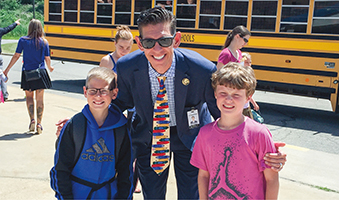
Decreasing Learning Loss With Balanced Calendars
BY DAVID G. HORNAK/
School Administrator, May 2018

|
Superintendent David Hornak with students in Holt, Mich., where two elementary schools run extended-year calendars.
|
One of the few constants in education over the past 150 years has been the 180-day school calendar, despite the learning gaps the long summer recess creates — gaps educators are working diligently to close.
Teachers in Holt Public Schools, located south of Lansing, Mich., wanted to reduce the amount of time spent reteaching curriculum from the prior year and provide more continuous learning than a traditional calendar year provides. The solution for us is a balanced calendar — also called a year-round or modified calendar — which shortens the summer recess and adds several short breaks throughout the year, helping reduce summer learning loss and maximize student achievement.
Two of Holt’s five elementary schools use a balanced calendar. Horizon Elementary (K-4) has been on a balanced schedule since it opened 24 years ago. Sycamore Elementary (K-4) implemented the modified calendar in 2013. Horizon and Sycamore students attend school for 180 days — the same number as a traditional calendar. However, the summer vacation is decreased to six weeks and students have several one- or two-week breaks throughout the year. Classes begin in early August and end in late June.
Continuous Education
A foundation of the balanced calendar is continuous access to instruction and education resources, which research shows is especially important in preventing summer learning loss for low-income students who may not have the benefits of travel, camps and trips to the library. We are able to provide that continuous access through our intersessions — the days students are on break. With the additional days, students might actually go to school for more than 200 days each school year.
In our district, families pay tuition for their students to take advantage of enrichment and/or remediation during intersessions. The tuition is less than the cost of child care, making intersessions attractive alternatives to staying home during a break.
Approximately 10 percent of our balanced calendar students take advantage of our enrichment and remediation sessions. Intersession activities offer our educators the opportunity to use thematic-based units in multi-aged cooperative learning classrooms. Recent themes included the Olympics, U.S. presidents and Australia.
Positive Outcomes
Parents have a voice in their children’s education — they may enroll their students in our balanced calendar schools or enroll them in traditional calendar schools. Some parents choose the traditional calendar because their other children attend schools on the traditional calendar, which makes coordinating vacations and out-of-school activities easier.
In many cases, our balanced calendar schools have waiting lists at some grade levels, as this instructional model is more aligned to lifestyles and work schedules.
Jennifer Robel, a balanced calendar parent, says, “Overall, parents continue to see tremendous academic and social growth in children who attend school on the balanced calendar. They see their children retaining what they have learned the previous school year. … Students and educators remain revitalized and refreshed on this continuous instructional cycle.”
In addition, our internal data provide a telling story. Since June 2000, 30 percent of the top 10 Holt High School graduates started their elementary school careers with a balanced schedule.
Are we going to add more schools to the balanced calendar? We are considering our options. However, the impact of the down economy over the past 10 years or so has left a mark that we need to address first, such as our weak infrastructure (road repairs and parking lot improvements).
Final Thoughts
The traditional school calendar requires teachers to re-teach between 20-40 school days each year. The amount of required time to reteach contributes to the learning gaps that we are trying so hard to close. By moving to the balanced calendar, we may be able to repurpose the funds that are being devoted to closing learning gaps — programs like summer school, intervention periods and after-school remediation — and earmark them instead for programs that focus on differentiating instruction or extending learning opportunities.
DAVID HORNAK is superintendent of Holt Public Schools in Holt, Mich. He also is executive director of the National Association for Year-Round Education. Twitter:
@davidghornak